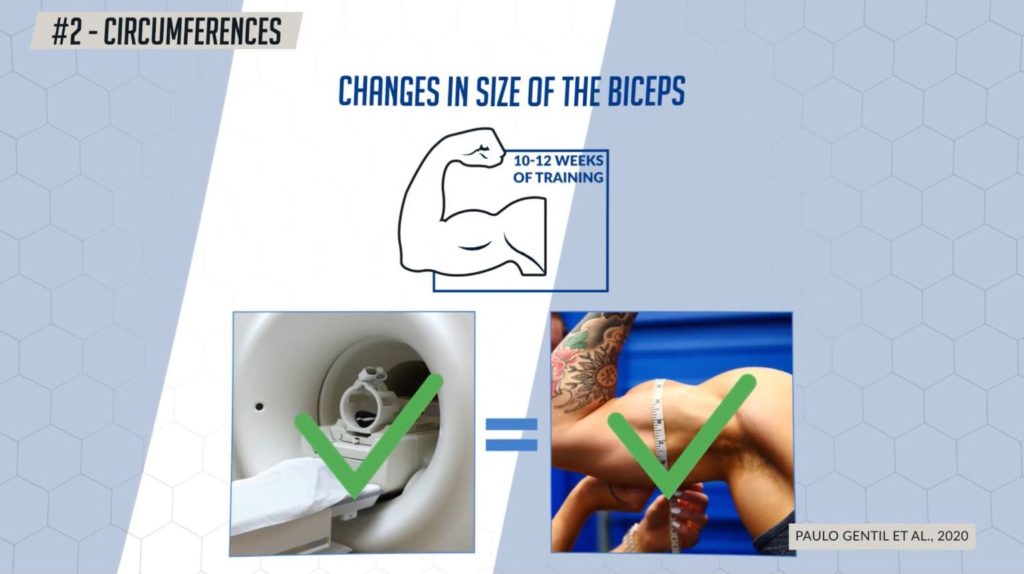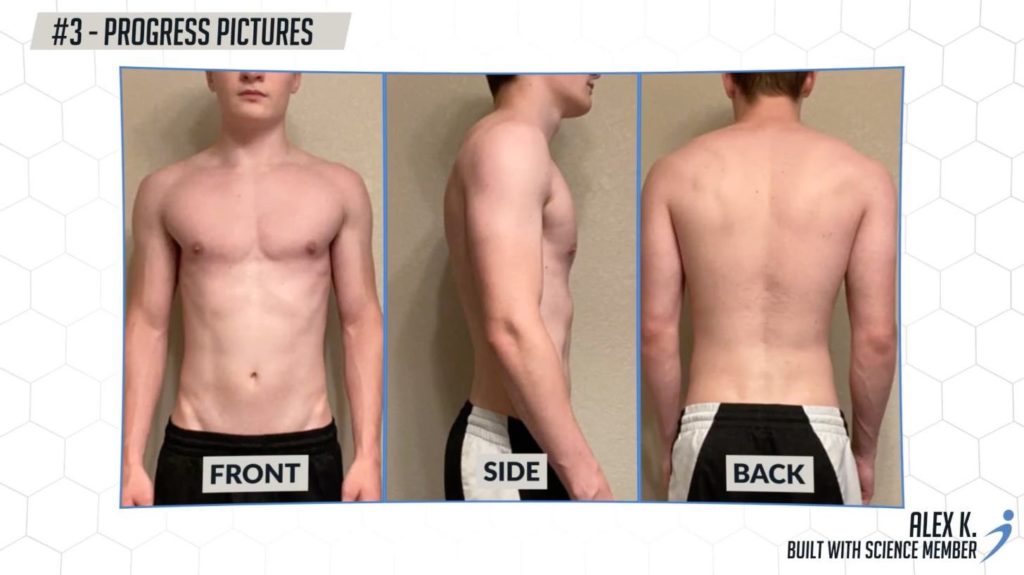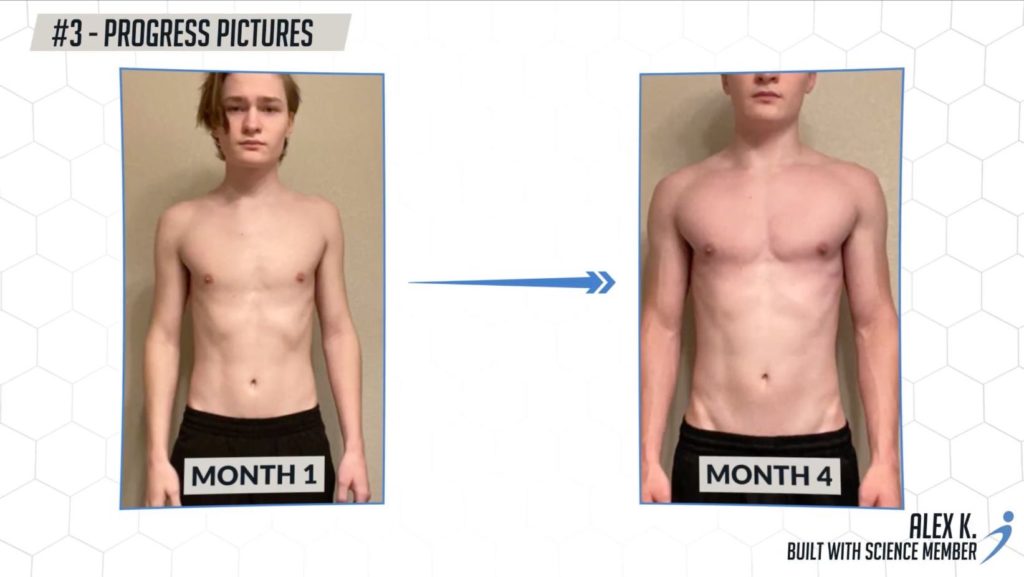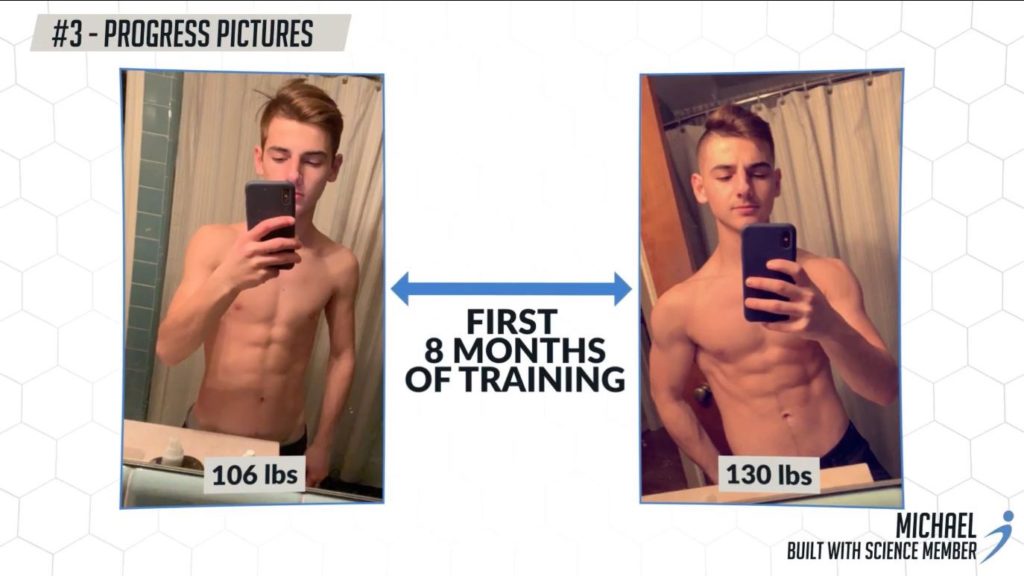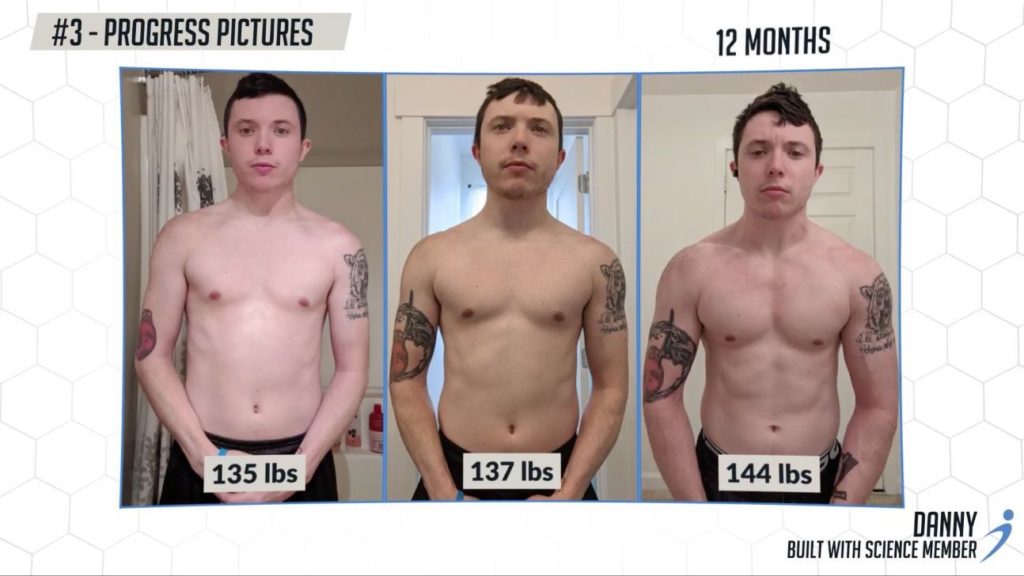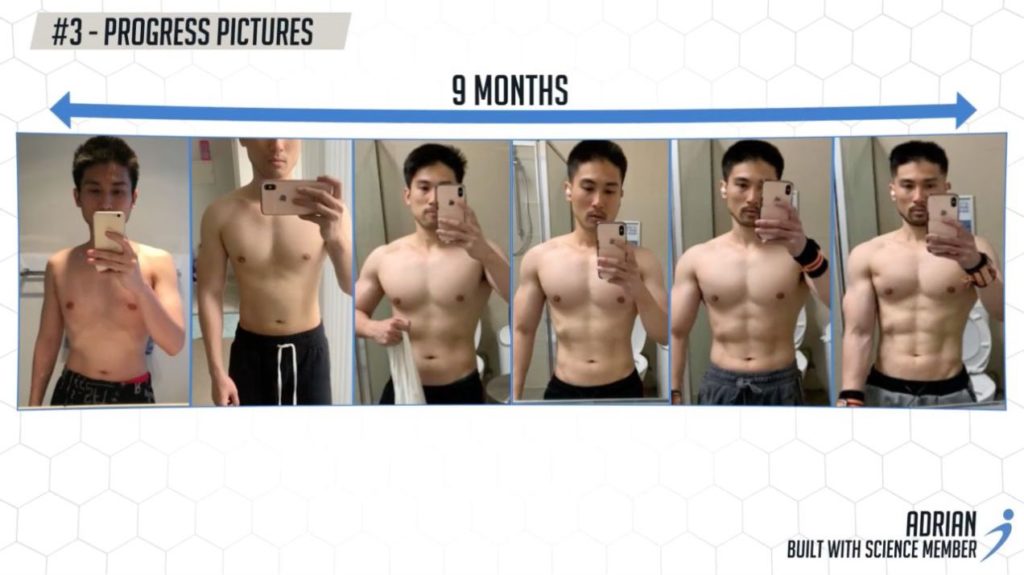Are You Making Muscle Gains? The 4 Ways To Find Out
You're putting on weight from all the hard work in the gym. But wait. How would you know (for sure) if this is indeed due to muscle gains, instead of fat? I show you 4 simple methods to tell.
Are you making muscle gains every week? Most people can't tell. As a result, they have no idea if what they're doing is actually working. To help you out, I'll show you 4 simple methods that will determine if you've put on more muscle. You'll want to pay close attention to every one of these 4 methods. Just relying on 1 of them won't be enough to tell if you're making muscle gains.
Of course, this assumes that you're training optimally for muscle growth. And that can only happen by following a well-structured training program - which, admittedly, can be challenging to come up with especially when you're a beginner. Luckily, every BWS program is designed to be an all-in-one, science-based process that’ll get you to your dream physique FAST. For more information:
Click the button below to take my analysis quiz to discover the best program for you:
↓
#1 - Track Fat-Free Mass (FFM)
One of, if not the most accurate ways to measure your muscle gains over time, is by tracking what's known as your fat-free mass. This is your body weight subtracted by how much fat you're currently carrying. For this method, you'll need to be able to track your body fat percentage over time.
Get Your Body Fat Percentage
As you'll see, there are a couple of ways to get this without having to do any fancy body fat tests.
Use An Electronic Scale
The easiest way is to get an electronic scale. It's worth noting that many claim that these scales are not accurate. While this may be the case in some circumstances, accuracy is actually not what we are worried about. What we are more concerned with is consistently tracking changes over time. And newer scales have been shown to be able to do just that.
Numerous studies have found that commercially available scales are able to detect changes in body fat similarly as well to more complex methods like skinfold calipers and DEXA.
For example, your scale may read that you are 20% body fat. But in reality, you are actually 15%. Despite this, if you lose or gain 5%, your scale would be able to accurately pick this up. Which is all that we need.
But at the same time, you still want to control for as many variables as possible. To do this, use your scale first thing in the morning after you go to the bathroom and before you eat or drink anything. This will allow you to get the most consistent reading to track changes over time.
A good quality scale won’t be expensive either. In fact, you can pick one up for less than 30 bucks. By the way: here's a link to one that I highly recommend.
Estimate Based On Circumference Measurements Formula
An alternative to tracking your body fat percentage would be through circumference measurement formulas. These are admittedly a little more cumbersome. But the good thing is that you don't need an electronic scale. And they're also shown to be accurate within 1-3%.
One of the most well-known and accurate of these formulas is the US Navy Equation. For men, this requires you to enter the following details:
- Age
- Height
- Neck
- Waist circumference
For women, you enter the same information - but with the addition of hip circumference. These measurements should all be taken relaxed, without flexing. You'll then want to input these into this online body fat calculator.
Calculate Rough Muscle Mass Percentage
Now, after you know your body fat percentage, it’s time to actually use it. Take your body weight and multiply it by your body fat percentage. This figure tells you how many pounds of fat you have.
For example, let's say that you weight 180 pounds - and that you have a 25% body fat. That means you have 45 pounds of fat on your body. Now, take your body weight and subtract your fat mass - this is how you calculate your fat-free mass (which includes muscle mass).
Looking back at the previous example, 180 lbs - 45 lbs of fat = 135 pounds of fat-free mass. Tracking this number over time is a great way to see if you are actually making muscle gains. Why? That's because, if you're staying consistent with how you weight yourself, any increase in fat-free mass is a very strong indicator of an increase in muscle mass.
How Fast Should You Be Making Muscle Gains?
How fast should your fat-free mass be increasing, though? Research can give some insights. As a point of reference, participants gain about 3-4 pounds of fat-free mass over a 12-week training program. This breaks down to about 1 pound per month.
Now, this is an average. Less-trained individuals will likely be able to make muscle gains at a much faster rate than this. Advanced individuals, on the other hand, should expect to gain muscle at a much slower rate.
In certain scenarios, you could even be gaining muscle as you're losing fat. This is a phenomenon known as body recomposition (i.e. simultaneous muscle gain and weight loss). And, in which cases, you can expect muscle gains to take place slower.
But overall, just keep these average numbers in mind. Track your fat-free mass at least monthly. And you'll be able to have a solid indication as to whether you're making muscle gains - and how it compares to the average.
#2 - Measure Your Muscle's Circumferences
A very practical way for you to track muscle gains progress is to just measure the circumference of your muscles. In a 2020 study, researchers measured the changes in bicep sizes after 10-12 weeks of training using either:
- Scientific standard of ultrasound OR
- Arm circumferences
The findings? It turned out that the circumference method was not significantly different from the more complex measuring methods when it came to tracking the percentage change in bicep size!
So, how can you practically apply this?
Well, the easiest way is to just pay attention to how your clothes fit. Are the sleeves on your shirt tighter? Are the thigh areas on your jeans tighter?
How To Increase The Accuracy Of This Measurement
Paying attention to this may be easy, yes. But it lacks accuracy.
An even better recommendation is to track the circumference of your bicep and thigh over time. This will give you good insights into the growth occurring in both your upper and lower body.
To achieve the best measurement for the upper body, flex your bicep. Measure around the largest area of the muscle. For the best results, take 3 measurements and average them together.
For the lower body, sit upright with your dominant leg propped up straight out in front of you. Flex your leg and take a measurement at the halfway point. Just like the bicep, repeat this 2 more times and take an average.
You may want to also take a measurement at the largest part around your butt just to keep track of those booty gains as well.
How Fast Should These Measurements Be Increasing?
As for how fast these measurements should be increasing (which is indicative of your muscle gains)? It appears that 8-12 weeks of training has been found to result in an approximate 4-6% increase in circumference in the arm and thigh.
As for how fast these measurements should be increasing, 8-12 weeks of training has been found to result in an approximate 4-6% increase in circumference in the arm and thigh. This translates to about a 2% increase per month.
For someone with 15-inch arms, they could expect an increase of about 1/2 an inch to 1 inch in bicep size over 2-3 months.
However, as you are building muscle and getting bigger, it is very likely that it will be accompanied by at least a little bit of fat which is often inevitable. So, how can you be confident that the increases you are measuring are due to muscle gains and not fat?
This is where the next method comes in, repetition strength.
By the way guys, within our step-by-step programs at builtwithscience.com we’ve built in easy-to-use trackers that make monitoring your progress a breeze. Knowing that what you’re doing is actually working is such a powerful source of motivation. And is a large part of the reason why our members are able to finally experience incredible results for the first time in their life For more information:
Click the button below to take my analysis quiz to discover the best program for you:
↓
#3 - Track Increases In Strength
During your first 12 weeks or so in training, the rapid increases you experience are mostly due to neurological changes as you get more skilled with your movements. Meaning? Initially, the correlation between your strength increases and actual muscle growth is quite poor. But this changes as you become more trained.
As you gain experience, the role that neurological factors play in strength decreases, while the rolw that muscle growth plays increases.
A 2019 study that compared the strength and size of untrained individuals to lifters with 3 years of training experience illustrates this point perfectly. Trained lifters were found to be almost 60% stronger than the untrained lifters - and that increases in muscle size alone were able to explain nearly 95% of this strength difference.
That said, 95% is not 100%. Meaning that even in trained lifters, there are factors outside of muscle growth that contribute to increases in strength. Regardless. What this does reinforce, however, is that after your first few months of training, you can start to use increases in strength as a pretty good indication that you're making muscle gains.
How To Gauge If You're Making Muscle Gains With This Method
So, how can you apply this to your own situation? How would you know if there is indeed an increase in muscle mass?
Well, if you've been training for at least a few months and are still getting stronger:
- Week after week OR
- At least, month over month
...Then you can be pretty confident that you are, in fact, building muscle and making progress.
As a point of reference, intermediate lifters who have been lifting for at least 6 months can reasonably expect to increase strength by 5-10% per month.
For example, let's assume that you've already been consistently training for a year. And you're able to increase the weight you use for 3 sets of 10 biceps curls from 35 pounds to 45 pounds. In this case, you can be pretty confident that you indeed have an increase in muscle mass. Of course, this is assuming that your form remains the same.
This is especially true if your arm circumference - based on the previous measuring method - also increased throughout this time.
Now, this method does come with some caveats. In certain scenarios, an increase in strength may not be as indicative of growth (i.e. muscle gains). But when it's used in combination with some of the other methods mentioned in this article, it can definitely be a good indicator to add to the list.
#4 - Take Progress Pictures
Lastly, progress pictures. This is also perhaps the most practical method. When done properly, this can help you visually see the added muscle and increased size you've put on.
That said, taking progress pictures is not as simple as finding your closest mirror - and snapping a picture whenever you think you look good.
Tips To Taking Progress Pictures For Better Insight Into Muscle Mass Increase
First off, consistency is key. Make sure you're taking them in the same conditions every single time. Ideally, you'll want to take these in the mornings before you've eating anything. You'll also want to strive for the same lighting conditions every time.
In addition to this, take pictures at the same time of the day - preferably in the morning, before you've eaten and definitely before you work out. Although the post-workout 'pump' picture can be great, it's not good for comparison.
Compare one picture of yourself from early in the morning before you've eaten anything to another picture right after an arm workout and a few meals ... and you'd be significantly misled. That's why our goal with progress pictures is to limit as many variables as possible.
When taking these photos, ideally try to get both the flexed and unflexed versions of the following shots (from the exact same angle):
- Front
- Back
- Side
How Long Before You Can Visually See Muscle Gains?
Take your progress pictures every 2-3 weeks and assess the difference. But just note that it can take several weeks - or even months - for differences in muscle growth to really become apparent.
If you're newer to the gym, you'll notice significant changes quickly, in as little as 4-6 weeks. Take Michael, for instance. He's a Built With Science member who went from 106 lbs to 130 lbs in his first 8 months of training.
Alternatively, for those who have been consistently training for over a year, you should only expect to see minor difference every 6-8 weeks. And even then, the muscle gains will be quite subtle. But will add up to significant improvements over the course of several months.
If you’re newer to the gym then you’ll notice significant changes quickly in as little as 4-6 weeks. Here’s our Built With Science member, Danny, to help illustrate this.
Note That Progress Pictures Can Sometimes Be Misleading
However, there is one major downside with this method. Unless you're actively striving for body recomposition (i.e. muscle gain and fat loss at the same time), when building muscle, it’s often inevitable that you will gain at least a small amount of fat as well.
Here's a point of reference. Even if your diet and training are both on track, weight gain typically occurs in the following ratio:
- 75% lean mass
- 25% fat mass
Meaning? If you have an increase of 5 pounds of muscle mass, it is likely that this will be accompanied by a little over a pound of fat.
Due to this, based on pictures alone, you might think that you're actually starting to look worse as you're building muscle. That's because the added fat can hide your muscle definition - and the added size you're putting on. In many cases, this means that you won't be able to visually see the added muscle you've put on until after you've committed to a diet to shred off the excess fat.
Adrian’s 9 month transformation from our Built With Science program showcases this quite well.
So, yes progress pictures can be easy and convenient compared to other methods. But they can ultimately be very misleading in certain cases. There are a lot of variables you'll need to control for. In fact, the same applies to any of the mentioned methods.
Finding Out If You're Making Muscle Gains: Takeaway
So, you wouldn't want to rely on any of these methods exclusively. Instead, you should use a combination of these different methods. Doing this will provide you with an accurate indication of whether you've made progress. It will also assure you that what you're currently doing is actually working.
If you are not actively tracking these 4 things, or at least a couple of them, then it is very likely you won’t be able to accurately tell if what you’re doing is actually working.
That’s exactly why, within our step-by-step programs, we not only provide you with science-based workouts and diet plans but then show you how to ensure you’re making progress week after week whether your goal is to lose fat or build lean muscle. Our programs have been proven to work regardless of your starting point, genetics, or current equipment limitations. To join today::
Click the button below to take my analysis quiz to discover the best program for you:
↓







